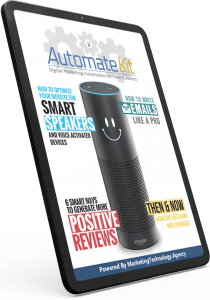#1: Optimize for Voice Search
 One of the biggest problems I see with websites is that many are using keywords that haven’t been updated in years. The days of short, generalized keywords are long past. Instead, focus on voice search, which is already important and on the rise.
One of the biggest problems I see with websites is that many are using keywords that haven’t been updated in years. The days of short, generalized keywords are long past. Instead, focus on voice search, which is already important and on the rise.
As of 2020, 50% of all searches will be voice-based. With virtual assistants like Siri, Alexa, and Cortana more popular than ever, it’s safe to assume that a hefty percentage of the people who land on your site will get there via voice search.
#2: Add Structured Landing Pages
Structured landing pages have content that’s easy for Google to interpret. They provide context for your content and identify how it relates to your metadata.
The best-known tool for structuring your content is Schema markup. Schema provides a vocabulary that web developers can use to structure data around people, places and things on the web.
When you add Schema markup to your site, it delivers rich snippets and rich cards as part of your search result on Google — making it easy for users to choose your site over the others that are available.
#3: Update Your SEO
Optimizing your website takes times, which is why a lot of companies do it only when they notice a big drop in their traffic. If it’s been a while since you updated your SEO, then it’s time to take another look. Why? Because Google updates its algorithm constantly.
The most important update in the past few years has to do with relevance. Google Rank Brain, which is now part of Google’s search algorithm, prioritizes sites based on their overall relevance to the term being searched. It measures bounce rates and the amount of time visitors spend on your site. The longer you can get them to stay – something that’ll happen if you provide tons of relevant content – the better off you’ll be.
#4: Be Ready for Mobile
 There’s really no reason for any website not to be mobile optimized at this point. Google rolled out its Mobilegeddon update back in 2015. That’s when they started to penalize sites that weren’t mobile optimized.
There’s really no reason for any website not to be mobile optimized at this point. Google rolled out its Mobilegeddon update back in 2015. That’s when they started to penalize sites that weren’t mobile optimized.
It’s not enough to have a mobile site now. You need a site that’s perfectly optimized for mobile users. That means that mobile visitors can get the same content and functionality as a visitor using a desktop computer regardless of which device they’re using.
Some things that are particularly important are having buttons that are right-sized for mobile users, content that’s easy to read with no teeny fonts or horizontal scrolling, and access to ALL the relevant content on your site – not just a few things.
#5: Gather Some Social Proof
Social proof can take many forms. Some of the most common kinds of social proof are:
- Customer reviews
- Customer testimonials
- Consumer ratings
- “Best Of” awards
- Industry awards
- Industry certifications
There’s plenty of research that shows that people give just as much importance to third-party reviews online as they would to a recommendation from a trusted friend. If you’re not including some type of social proof on your website, then you’re missing out on an opportunity to show casual visitors to your site that they can trust you.
#6: Improve Your Page Loading Time
 How quickly does your website load? If the answer is more than four seconds, then it’s a virtual certainty that you’re losing visitors as a result. After just three seconds, approximately 53% of mobile users will navigate away from a site and try another one. The numbers are just as bad for desktop users.
How quickly does your website load? If the answer is more than four seconds, then it’s a virtual certainty that you’re losing visitors as a result. After just three seconds, approximately 53% of mobile users will navigate away from a site and try another one. The numbers are just as bad for desktop users.
The problem with not updating your website often is that technology keeps moving. You can use a free online site loading speed testing tool such as Pingdom to see how fast your site loads. If it’s not making the grade, you’ll need to upgrade it to ensure that you’re not losing customers faster than you can attract them.
#7: Update Your Call to Action
Calls to action are everywhere – in every marketing email you send and on every landing page you create. However, not all CTAs are created equal. And if your calls to action are outdated and tired, then you might be losing subscribers and leads as a result.
Think about the opt-in form for your mailing list. What’s the call to action? Does it just say SUBSCRIBE or SUBMIT? If it does, then it’s time to rethink it and give it some spice.
I’m a big fan of calls to action that emphasize something positive about subscribing to your list. Here are a few examples:
- Yes! Send me special offers each week!
- Download our “10 pounds in 10 Days” Workout for FREE!
- I’m ready to save 20% on my car insurance!
I also like the idea of using humorous opt-outs because I think they nudge people in the direction of subscribing. Here are some opt-outs that could pair with the calls to action above:
- No, saving money is not for me
- I don’t need any weight loss help – my abs are perfect.
- No thanks, I’d rather pay more somewhere else.
Those are goofy, but I’ve seen a lot of opt-in forms with similar wording – and for good reason. They’re effective. Let’s face it, it feels a little silly to click a button to say you don’t like money.
Your website might be out of date, but it doesn’t need to stay that way. The 7 quick fixes here will help you give your Google rank a boost and ensure that you’re not missing out on leads and subscribers because your website’s more vintage than modern.











